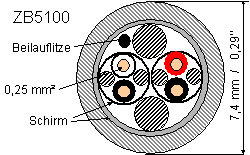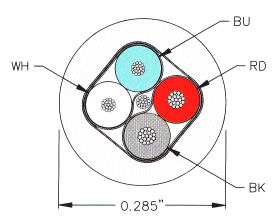Cabling
CAN is a 2-wire bus system, to which all participating devices are connected in parallel (i.e. using short drop lines). The bus must be terminated at each end with a 120 (or 121) Ohm terminating resistor to prevent reflections. This is also necessary even if the cable lengths are very short!
Since the CAN signals are represented on the bus as the difference between the two levels, the CAN leads are not very sensitive to incoming interference (EMI): Both leads are affected, so the interference has very little effect on the difference.
Additional shielding of the twisted wires can be used to further reduce EMI interference.
Bus length
The maximum length of a CAN bus is primarily limited by the signal propagation delay. The multi-master bus access procedure (arbitration) requires signals to reach all the nodes at effectively the same time (before the sampling within a bit period). Since the signal propagation delays in the CAN connecting equipment (transceivers, opto-couplers, CAN controllers) are almost constant, the line length must be chosen in accordance with the baud rate:
Baud rate | Bus length |
|---|---|
1 Mbit/s | < 20 m* |
500 kbit/s | < 100 m |
250 kbit/s | < 250 m |
125 kbit/s | < 500 m |
50 kbit/s | < 1000 m |
20 kbit/s | < 2500 m |
10 kbit/s | < 5000 m |
*) A figure of 40m at 1 Mbit/s is often found in the CAN literature. This does not, however, apply to networks with optically isolated CAN controllers. The worst case calculation for opto-couplers yields a figure 5 m at 1 Mbit/s - in practice, however, 20 m can be reached without difficulty.
It may be necessary to use repeaters for bus lengths greater than 1000 m.
Drop lines
Drop lines must always be avoided as far as possible, since they inevitably cause reflections. The reflections caused by drop lines are not however usually critical, provided they have decayed fully before the sampling time. In the case of the bit timing settings selected in the Bus Couplers it can be assumed that this is the case, provided the following drop line lengths are not exceeded:
Baud rate | Drop line length | Total length of all drop lines |
|---|---|---|
1 Mbit/s | < 1m | < 5 m |
500 kbit/s | < 5 m | < 25 m |
250 kbit/s | < 10 m | < 50 m |
125 kbit/s | < 20 m | < 100 m |
50 kbit/s | < 50 m | < 250 m |
Drop lines must not have terminating resistors.
Star Hub (Multiport Tap)
Shorter drop line lengths must be maintained when passive distributors ("multiport taps"), such as the BECKHOFF ZS5052-4500 Distributor Box. The following table indicates the maximum drop line lengths and the maximum length of the trunk line (without the drop lines):
Baud rate | Drop line length with multiport topology | Trunk line length (without drop lines) |
|---|---|---|
1 Mbit/s | < 0.3 m | < 25 m |
500 kbit/s | < 1.2 m | < 66 m |
250 kbit/s | < 2.4 m | < 120 m |
125 kbit/s | < 4.8 m | < 310 m |
CAN cable
Screened twisted-pair cables (2x2) with a characteristic impedance of between 108 and 132 Ohm is recommended for the CAN wiring. If the CAN transceiver’s reference potential (CAN ground) is not to be connected, the second pair of conductors can be omitted. (This is only recommended for networks of small physical size with a common power supply for all the participating devices).
ZB5100 CAN Cable
A high quality CAN cable with the following properties is included in BECKHOFF's range:
- 2 x 2 x 0.25 mm² (AWG 24) twisted pairs, cable colors: red/black + white/black
- double screened
- braided screen with filler strand (can be attached directly to pin 3 of the 5-pin connection terminal),
- flexible (minimum bending radius 35 mm when bent once, 70 mm for repeated bending)
- characteristic impedance (60kHz): 120 ohm
- conductor resistance < 80 Ohm/km
- sheath: grey PVC, outside diameter 7.3 +/- 0.4 mm
- Weight: 64 kg/km.
- printed with "BECKHOFF ZB5100 CAN-BUS 2x2x0.25" and meter marking (length data every 20cm)

ZB5200 CAN/DeviceNet Cable
The ZB5200 cable material corresponds to the DeviceNet specification, and is also suitable for CANopen systems. The ready-made ZK1052-xxxx-xxxx bus cables for the Fieldbus Box modules are made from this cable material. It has the following specification:
- 2 x 2 x 0.34 mm² (AWG 22) twisted pairs
- double screened braided screen with filler strand
- characteristic impedance (1 MHz): 126 ohm
- conductor resistance 54 Ohm/km
- sheath: grey PVC, outside diameter 7.3 mm
- printed with "InterlinkBT DeviceNet Type 572" as well as UL and CSA ratings
- stranded wire colors correspond to the DeviceNet specification
- UL recognized AWM Type 2476 rating
- CSA AWM I/II A/B 80°C 300V FT1
- corresponds to the DeviceNet "Thin Cable" specification

Shielding
The screen is to be connected over the entire length of the bus cable, and only galvanically grounded at one point, in order to avoid ground loops.
The design of the screening, in which HF interference is diverted through R/C elements to the mounting rail assumes that the rail is appropriately earthed and free from interference. If this is not the case, it is possible that HF interference will be transmitted from the mounting rail to the screen of the bus cable. In that case the screen should not be attached to the couplers - it should nevertheless still be fully connected through.
Cable colors
Recommended application of Beckhoff CAN cables:
Function | ZB5100 cable color | ZB5200 cable color |
|---|---|---|
CAN Ground | black/ (red) | black |
CAN Low | black | blue |
Shield | Filler strand | Filler strand |
CAN high | white | white |
not used | (red) | (red) |